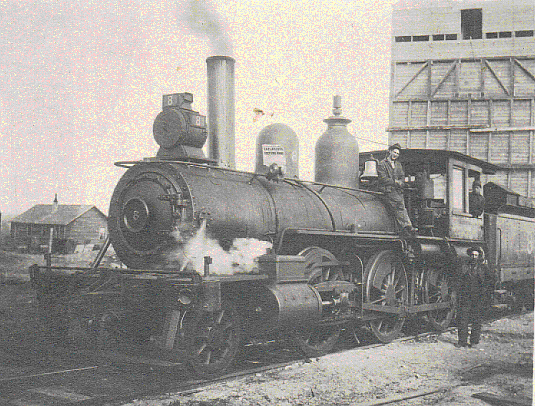
The railway played an important role in the history of Lethbridge. Because of the railway a wave of prosperity and technology swept over southern Alberta. Southern Alberta became a popular place for people to settle. The large production of steam power through coal, the construction of a world renowned bridge, and the transportation many of settlers all demonstrate this new found success. The large amounts of freight that moved through Lethbridge helped bring this success to southern Alberta.

P19800040000-GP A locomotive that was used to pull loads of freight.
It was the need to transport coal that first brought rail lines into southern Alberta. Most of the coal produced in the Lethbridge area was used all around western Canada for heating, electric power generation, and railway use. The coal had to be moved to markets throughout the prairies, and the rails were seen as the best way of doing this. As time passed coal became less important because people began to use oil, gas, and other petroleum products instead of coal.
Like many other items, livestock was transported mostly by rail. As ranches in the late 1890s prospered, they needed better rail services than before. Railway stockyards were built at nearly every station in southern Alberta so that cattle could have water and food while they were traveling to the packing plants. As paved highways improved and trucking became more dependable stock buyers soon found it was cheaper to move stock by truck than rail.
 This
is a coal heater used to keep train cars warm.
This
is a coal heater used to keep train cars warm.
As grain farmers moved west to homestead they realized how important the railway was to their success. Without the rails the farmers would have no link to the rest of the world and no way of getting their products to market. Part of this involved farmers depositing their grain in elevators in order for it to be weighed and stored. There are few communities in southern Alberta that have never had a rail link or a grain elevator in their town. Because of this grain, elevators are recognized symbols of prairie communities. As southern Alberta grew other types of agriculture became important. The farmers who grew many different types of vegetables moved their products with trucks. But grain is still transported by the railways and continues to be one of the most important parts of rail traffic.

The C.P.R. crest for many years. Over the decades the crest changed, but the beaver remained for a long time.
When thinking about the different kinds of industries that have helped Lethbridge develop, the railways become very important. The rails brought people, money, packages, food, and business to the city. In many ways it was the life line to the outside world. As part of this life line, Lethbridge became a major service center for the C.P.R. This service centre was a train station that fixed broken locomotives, delivered people and freight and, gave many people in Lethbridge jobs. Being a service center for the C.P.R. was important to Lethbridge, the C.P.R.’s presence was a great influence on how southern Alberta grew and evolved. Without the C.P.R. the City of Lethbridge and southern Alberta would be very different today.
Previous Page | Exhibit Contents | Home | Navigation Information | Glossary | Curriculum Guide | Next Page
Copyright © 1996 Sir Alexander Galt Museum. All rights reserved.